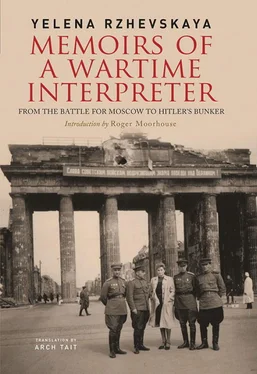In 1933, after the ominous ‘false flag’ arson attack on the Reichstag, Hitler was able to force the aged President Hindenburg ‘temporarily’ to suspend civil liberties. They were never restored. This allowed Hitler to carry out a clampdown, with mass arrests of Communists and Social Democrats, giving the Nazis an absolute majority in the Reichstag. The burned-out building was not repaired and, under the Nazi regime, parliament ceased to be important. Its subsequent infrequent sessions were held elsewhere.
The principal building under the new regime was a new Reich Chancellery, built specially for Reich Chancellor Hitler by his favourite architect, Albert Speer (later Minister of Armaments and War Production). It was 500 metres from the Reichstag.
At that time we still had no firm intelligence to confirm that Hitler and his staff headquarters were in the shelter beneath the Reich Chancellery. Such information as the intelligence services had was scanty, inconsistent, unreliable and contradictory. Captured German soldiers had little to tell us. Some believed Hitler had flown to Bavaria or elsewhere, others were totally indifferent to everything, including the matter of where he might be. They were overwhelmed and burned out by what they had been through.
A squealer was captured, a boy of fifteen or so in the uniform of the Hitler Youth, his eyes reddened, his lips cracked. He had been shooting furiously but now just sat there, looking around puzzled but with evident curiosity, like any other young kid. These instant transformations in the war always amazed me. He told us that their division, commanded by Reichsjugendführer Artur Axmann, the national leader of the Hitler Youth, was protecting Hitler. He had heard that from their commanders. They had kept repeating it, and saying it was essential to hold out until General Wenck’s army came to the rescue.
All day I had to interpret at the interrogation of prisoners in the basement of a house not far from Potsdamer Platz. It was occupied by a tailor’s family, also by a woman and her son, and a girl in a ski outfit. The ceaseless thunder of battle was muffled in the basement. Sometimes we experienced what felt like earthquake tremors.
The tailor, an elderly man, hardly ever got up from his chair. He often took out his pocket watch and inspected it at length. Everyone involuntarily watched him doing so. His grown-up son was a cripple who had contracted polio as a child; he sat at the tailor’s feet with his head on his father’s lap. The elder daughter was either asleep or rushed round looking anxious. Her husband was in the Volkssturm and was outside somewhere in the streets of Berlin. Of all these bewildered, worn-out people, only the tailor’s wife was busy with something all the time; her duties as a mother took priority over war or her fear of death. At the appropriate time, she would spread a napkin on her knees and lay out tiny pieces of bread and jam.
The young woman with the thin, serious boy and the girl in the ski suit, were ‘refugees’ from another basement. They tried to take up as little space as possible. The woman periodically talked loudly about herself: she was married to a firefighter who had been mobilized and sent to the front. She had been waiting two years for her husband to come home on leave, and had made a list of things he needed to do in the apartment: change a door handle, fix the window fastenings, etc., but now their house had burned down. The boy scowled, evidently tired of listening yet again to his mother’s stories. The girl was wearing rough boots and had a pack on her back that she could not bring herself to take off. She was ugly and gawky and nobody asked her who she was or where she came from.
Prisoners waiting to be called for interrogation sat in there also. A not particularly young German lieutenant told me quietly, ‘I’ve spent half the day sitting among civilians,’ by which he meant the occupants of the basement. ‘I’m not sure if you’re aware of that.’ ‘What can we do?’ ‘No, by all means, if they are decent people I don’t mind.’
We were interested in just one thing: where was Hitler? He did not have the answer to that, but wanted to speak his mind, and started in a roundabout way. He stood up and straightened himself before beginning. ‘Our enemy No. 1 was England. Enemy No. 2 was Russia. In order to defeat England, we had first to finish off Russia… Oh God!’ he said and covered his face with his hands.
A miner from Alsace who had surrendered asked darkly to be trusted with a rifle so he could fight against the Germans. ‘Even at this last minute,’ he said, ‘for everything!’ He turned up his sleeve to show the tattoo of a cross, which confirmed he came from Alsace.
Scant though the intelligence was that we obtained, putting everything together, getting an insight into the structure of the German defences around the Reich Chancellery, we felt able to conclude that, most likely, that is where Hitler was.
On the evening of 29 April a nurse was detained who had run through the line of fire to look for her mother. As she talked to us, she pulled a white headscarf from her coat pocket, either without thinking or seeking the protection of the red cross on its white background. Throughout the war that sign had afforded our wounded no protection. At first sight of it the Germans mercilessly targeted their bombing there.
The day before, the nurse had been accompanying the wounded from Vossstrasse to the only nearby place of safety, the bomb shelter of the Reich Chancellery. There she had heard from the soldiers and the staff of the building that Hitler was in the underground bunker.
White Flags
Dawn. Streets after fighting. A dead German soldier. Shop windows ripped apart by shells, holes in walls leading deep into the interior of a deserted house. The wind sweeping rubbish and crushed stone over a cobbled street. By a building, on the pavement, are our soldiers. One is sleeping on his side, his knees drawn up, using a piece of a door as a headrest. Another is rewinding his foot wrappings. The last long minutes before another day of assault…
Everywhere there are barricades, anti-tank barriers, ditches and piles of rubble. Labyrinthine streets. Chaotic ruins. Burning, collapsing buildings, and buildings from whose windows the enemy is firing. Our soldiers rose to face death with unforgettable courage and selflessness in those testing years when death was not rewarded with victory; but there is a particular grief when a soldier dies with only a few hours left before victory. The Russian soldiers who entered Berlin had been through everything: pain and hatred, the bitterness of defeat and self-sacrifice, the hopelessness of encirclement, the despair of captivity, the rage of attacking, and the surge of enthusiasm in victorious battles from the Volga to the Spree – only for many of them to be cut down at the last minute in the streets of Berlin.
The battle raged day and night, ever fiercer. The Berlin garrison, the SS regiments, the troops retreating from the Oder and Küstrin or redeployed from the Elbe, all those troops that managed to get through to Berlin before the ring of encirclement closed around the city, were concentrated here in the government district.
On 30 April at 11.30 hrs the order was given to the attacking troops: fire with all weaponry! The bombardment began, from heavy artillery, the selfpropelled guns, tanks, fire from machine guns and submachine guns. Guns that had come all the way from the Volga fired for all the wrongs that had been done, for all the people who had been harmed. When the artillery fell silent, the soldiers attacked.
On the evening of that day, 30 April 1945, the red flag fluttered over the Reichstag. Fighting within the building itself continued throughout 1 May.
Читать дальше











